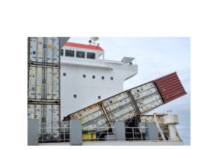
When the Red Sea crisis broke out and vessels started rerouting around Africa, the Asia-Europe supply chain became 7-14 days longer, depending on port-pair configurations. As supply chains lengthen, shippers typically increase their inventories to account for the longer transit times, effectively treating the cargo on the ships as inventory.
In 2024, demand on the Asia-Europe route grew by 8.5%. However, after factoring in the longer transit times and the associated increase in inventory (7-14 days), the actual growth rate for Asia-Europe drops to 4.5%-6.5%, depending on how much the supply chain lengthened.
This indicates that the growth in Asia-Europe trade was boosted by 2-4 percentage points (PP) purely due to the longer supply chain.
“If we reasonably average the supply chain lengthening to 10 days, then the demand growth boost on Asia-Europe equates to 2.9 PP,” noted Alan Murphy, CEO of Sea-Intelligence.
Once vessels return to the Suez routing, the supply chain will shorten by the same amount it had lengthened in 2024, according to the Sea-Intelligence report, as this will result in the release of the excess inventory accumulated during the extended supply chain.
In response, importers will likely reduce their ordering to adjust for the sudden surplus of inventory, say the Danish analysts.
“The effect on demand for the Asia-Europe route will be symmetrical on an annual basis, meaning we can expect a negative impact of -2.9 PP on demand growth in the year following the reopening of the Suez Canal. However, the contraction of the supply chain will likely occur much more quickly than its expansion, which could amplify the impact,” explains Murphy.

Alan Murphy, CEO of Sea-Intelligence, went on to add: “We do not know how quick this process will be and have therefore modelled a range of scenarios ranging from two weeks (unrealistically fast) to 12 weeks. This is shown in the figure. In the case of the unrealistic two-week contraction, we see how the volume drops by 70 percentage points Y/Y – an event even more extreme than the usual lull after Chinese New Year. Even at a 12-week transition period, this still leads to a reduction in Asia-Europe Y/Y growth by more than 10 percentage points over the full 12 weeks.”





